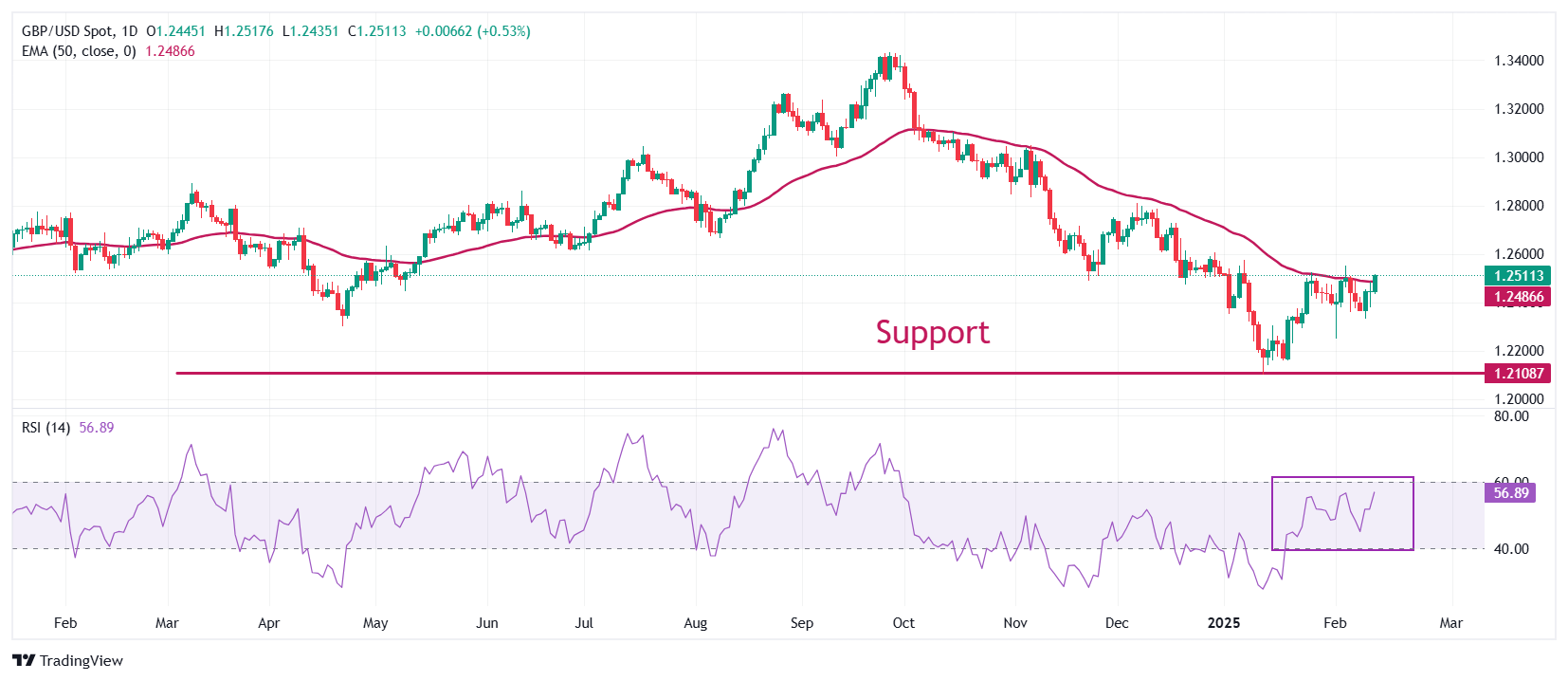Pound Sterling outperforms US Dollar on hopes of Russia-Ukraine truce
- The Pound Sterling advances as the UK GDP rose at a robust pace in December and surprisingly expanded in the last quarter.
- BoE's Greene and Pill have guided a gradual and cautious approach to interest rate cuts.
- Investors brace for volatility as US President Trump is poised to announce reciprocal tariffs.
The Pound Sterling (GBP) climbs to near the psychological resistance of 1.2500 against the US Dollar (USD) in European trading hours on Thursday. The GBP/USD pair strengthens as positive developments in peace talks between Russia and Ukraine have overcome the impact of hotter-than-expected United States (US) Consumer Price Index (CPI) data for January released on Wednesday, which boosted expectations that the Federal Reserve (Fed) will keep interest rates at their current levels for longer.
US President Donald Trump confirmed on Wednesday that Russian leader Vladimir Putin and Ukrainian President Volodymyr Zelenskiy had expressed a desire for peace in separate phone calls. He also ordered his top officials to begin truce talks, Reuters reports. This scenario has increased investors' risk appetite and diminished demand for safe-haven assets, such as the US Dollar. The US Dollar Index (DXY), which gauges the Greenback’s value against six major currencies, slides to near 107.50.
The US annual headline inflation accelerated to 3% in January from the estimates and the prior release of 2.9%. The core CPI inflation – which excludes volatile food and energy prices – surprisingly grew at a faster pace of 3.3% than 3.2% in December. Hotter-than-expected inflation data has forced trades to pare bets supporting an interest rate cut by the Fed in the June meeting. According to the CME FedWatch tool, there is a 36% chance that the Fed will cut interest rates in June, down from 50% on Tuesday.
Going forward, the next trigger for the US Dollar will be President Trump’s decision on reciprocal tariffs, which he is expected to impose on Thursday. The White House said on Wednesday that Trump could announce his reciprocal tariff plan before he meets with Indian Prime Minister Narendra Modi on Thursday, CNBC reported. Trump's announcement of reciprocal tariffs could increase the safe-haven appeal of the US Dollar again.
On the economic data front, investors will focus on the US Producer Price Index (PPI) data for January, which will be published at 13:30 GMT.
Daily digest market movers: Pound Sterling gains sharply on upbeat UK GDP data
- The Pound Sterling strengthens in Thursday’s European session due to multiple tailwinds, such as upbeat United Kingdom (UK) data and a risk-on market mood. The UK Office for National Statistics (ONS) reported that the UK Gross Domestic Product (GDP) rose at a faster pace of 1.4% YoY in the last quarter of 2024, compared to estimates of 1.1% and the 1% growth seen in the third quarter, upwardly revised from 0.9%.
- Quarterly, the UK economy surprisingly expanded by 0.1% after remaining flat in the July-September period, while it was expected to have contracted at a similar pace. Month-on-month, the UK economy grew at a robust pace of 0.4% in December, compared to estimates and the former reading of 0.1%.
- Though the UK GDP data had been better than expected in December and the last quarter of the previous year, it is unlikely to offer sustainable support to the British currency as the Bank of England (BoE) halved its GDP forecasts for the year to 0.75% in the last week’s monetary policy meeting, where the central bank reduced its borrowing rates by 25 basis points (bps) to 4.5% and guided caution on interest rate cuts.
- BoE officials have been guiding a cautious approach to interest rate cuts as they remain concerned about the mild persistence of inflationary pressures. BoE Chief Economist Huw Pill said earlier in the day that the central bank needs to move cautiously on further policy easing, as the battle against inflation is far from over.
- "We are able to remove some of the restriction we imposed because of the successful - but not yet complete - process of disinflation,” Pill said, Reuters report. Additionally, he stated that the BoE has to work more to “bring inflation down” and, therefore, we can’t “cut interest rates aggressively”.
- On Wednesday, BoE policymaker Megan Greene also favored a “cautious and gradual approach to interest rate cuts” as she believes that inflation persistence will less likely fade on its own, and therefore, the monetary policy will need to “remain restrictive.”
- Meanwhile, the UK factory data also remained stronger than expected in December. Month-on-month Industrial Production rose by 0.5%, faster than estimates of 0.2%. The Manufacturing Production grew by 0.7%, while it was expected to decline by 0.1%. In November, both Industrial and Manufacturing Production declined.
Technical Analysis: Pound Sterling reclaims 50-day EMA
The Pound Sterling surges to near 1.2500 against the US Dollar and revisits the 50-day Exponential Moving Average (EMA) in European trading hours on Thursday after an indecisive Wednesday. A daily close above the 50-day EMA would indicate that the near-term trend is not bearish anymore.
The 14-day Relative Strength Index (RSI) oscillates inside the 40.00-60.00 range, suggesting a sideways trend.
Looking down, the January 13 low of 1.2100 will act as a key support zone for the pair. On the upside, the December 30 high of 1.2607 will act as key resistance.


